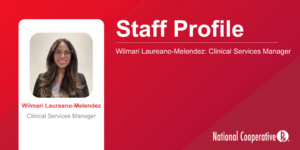National CooperativeRx constantly monitors the pharmaceutical pipeline. As treatment options change, it’s important to know how those changes could impact your plan and which drugs bring the highest value. Our quarterly NCRx Pipeline Reports highlight some of the newest therapies coming to market and are not intended to imply formulary placement or coverage by CVS Caremark.
Ubrelvy® (ubrogepant) and Nurtec® (rimegepant): These drugs are oral calcitonin gene-related peptide (CGRP) inhibitors for acute treatment of migraine. There are also three injectable CGRP drugs which are indicated for prevention of migraine and trials are underway to study the combined use of injectable and oral CGRPs. In the ACHIEVE clinical trial, 21.8% of patients who took a 50mg dose of Ubrelvy® were pain-free in two hours.1 Similarly, in a phase III clinical trial, 21% of patients who took a 75mg dose of Nurtec® were pain free in two hours.2 For reference, sumatriptan, a common migraine medication, reduces headache pain to mild or none within two hours in about 55%-65% of people.3 The drugs are relatively well-tolerated, but do come with a host of interactions with other drugs and dose adjustments for kidney and liver disease. Their place in migraine therapy is likely after failure of a “triptan” medication, which is a type of medicine used to treat migraine or cluster headaches.
Anticipated Launch: Currently available.
Impact: Low. While additional treatments for migraine are always welcome, significant drug interactions are likely to hinder use.
Price: $106 per day for Nurtec® and $85-$170 per day for Ubrelvy®.
Dupixent® (dupilumab): This medication is used for the treatment of severe atopic dermatitis (eczema) in children ages six to 11 years old. Dupixent® is currently approved for patients older than 12 years with moderate to severe atopic dermatitis, so this indication would extend use to younger patients with more severe disease. In a trial submitted to the US Food and Drug Administration (FDA) for approval, about a third of patients taking Dupixent® saw clear or almost clear skin after 16 weeks.4 However, the Dupixent® utilizers also experienced more colds, pink eye infections and injection-site reactions than the placebo group. Still, approval of Dupixent® in this age group will be important as the disease usually presents in childhood and affects 13% of children in the US.5 Its place in therapy should likely follow failure of topical agents for atopic dermatitis, like pimecrolimus (Elidel) and steroid creams. Dupixent® studies are also underway for pediatric asthma and atopic dermatitis (ages six to 11 years) and pediatric atopic dermatitis (ages six months to five years).
Anticipated Launch: Quarter two of 2020 for the pediatric indication.
Impact: High. An estimated 600,000 children in the US have severe eczema5 and treatment can be difficult.
Price: An estimate based off current Dupixent® pricing is $1,300-$1,600 per month.
Ocaliva (obeticholic acid): This drug is used to treat liver fibrosis due to non-alcoholic steatohepatitis (NASH), a leading and increasing cause of liver transplant in the US. It is estimated that 80 to 100 million people currently have fatty liver disease, and 25% of these are expected to progress to NASH.6 Ocaliva was first approved in 2016 for the treatment of another type of liver disease, but approval for NASH would make it the first treatment available for the condition. Additionally, non-invasive testing for NASH is likely to be available soon, replacing the current method of liver biopsy. The combination of easier testing along with a new treatment option may result in a significant spend increase for this disease. An interim data analysis published in 2019 indicated that Ocaliva improves fibrosis in about 23% of patients taking a 25mg daily dose compared to 12% with placebo. The most common side effect is itching which occurs in 51% of users.7 Non-drug treatments for NASH include weight loss, improvement in diet and exercise, which can be remarkably effective.
Anticipated Launch: June of 2020. The original expectation was March 2020, but the FDA Advisory Committee meeting has been delayed due to COVID-19.
Impact: High. Non-invasive testing capabilities along with new drug treatments have the potential for a large impact to spend for this condition. 20 to 25 million people in the US are believed to have NASH.
Price: 25mg tablets are not yet available, but current monthly cost for a 10mg dose is $6,900.
(Risdiplam): This is an oral drug used to treat spinal muscular atrophy (SMA) types one, two and three. SMA is a genetic disorder disease that causes muscle wasting and loss of nerve cells in the spinal cord; it is disabling and sometimes fatal. Currently, the only drugs available for SMA are Spinraza (nusinersin), which must be injected into the spinal fluid, and Zolgensma (onasemnogene abeparvovec-xioi) which is only for patients under two years of age. In early February, biotech company Roche shared that risdiplam showed a significant improvement in motor function compared to placebo in patients two to 25 years old with SMA types two and three. The effect was the greatest for younger patients, two to five years old. The most troubling side effect was serious lower respiratory infections which occurred in 10% of the risdiplam group and only 2% in the placebo group.8 Other side effects occurred at a rate similar to placebo. Additional trials are underway to include a wider age range and SMA type one patients.
Anticipated Launch: May of 2020.
Impact: Low to moderate. Currently, the only drug available for patients over two years old is Spinraza (nunisnersin), which must be injected into the spinal fluid; this drug may replace some Spinraza utilization. 10,000 to 25,000 people in the US have SMA.
Price: Currently unknown but will likely be competitive with Spinraza which is priced at $750,000 for the first year and $375,000 annually thereafter.
- Lipton RB, Dodick DW, Ailani J, et al. Effect of Ubrogepant vs Placebo on Pain and the Most Bothersome Associated Symptom in the Acute Treatment of Migraine. JAMA 2019; 322(19):1887-1898.
- Croop R, Goadsby PJ, Stock DA, Conway CM, Forshaw M, Stock EG, Coric V, Lipton RB. Efficacy, safety, and tolerability of rimegepant orally disintegrating tablet for the acute treatment of migraine: a randomised, phase 3, double-blind, placebo-controlled trial. Lancet 2019 Aug 31; 394(10200):737-745.
- Imitrex [package insert]. Research Triangle Park, NC: GlaxoSmithKline; 2017
- Dupixent (dupilumab) showed positive topline results in phase 3 trial of children aged 6 to 11 years with severe atopic dermatitis [news release]. Regeneron. https://investor.regeneron.com/news-releases/news-release-details/dupixentr-dupilumab-showed-positive-topline-results-phase-3. Accessed March 17, 2020.
- Silverberg JI, Simpson EL. Associations of childhood eczema severity: A US population based study. Dermatitis 2014 May-Jun; 25(3): 107–114.
- Perumpail BJ, Khan MA, Yoo ER, Cholankeril G, Kim D, and Ahmed A. Clinical epidemiology and disease burden of nonalcoholic fatty liver disease. World J Gastroenterol 2017 Dec 21; 23(47): 8263–8276.
- Younossi ZM, Ratziu V, Loomba R, et al. Obeticholic acid for the treatment of non-alcoholic steatohepatitis: interim analysis from a multicentre, randomised, placebo-controlled phase 3 trial. Lancet 2019 Dec 14; 394(10215):2184-2196.
- Roche’s risdiplam showed significant improvement in motor function in people aged 2-25 with type 2 or 3 spinal muscular atrophy. [news release]. February 6, 2020. https://www.roche.com/media/releases/med-cor-2020-02-06.htm. Accessed March 18, 2020.




